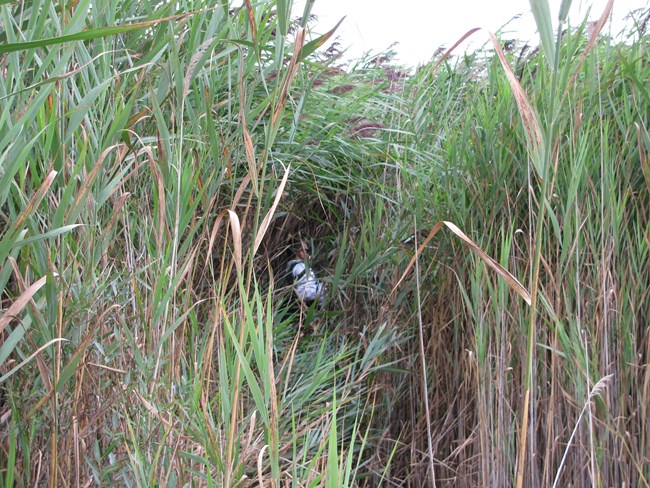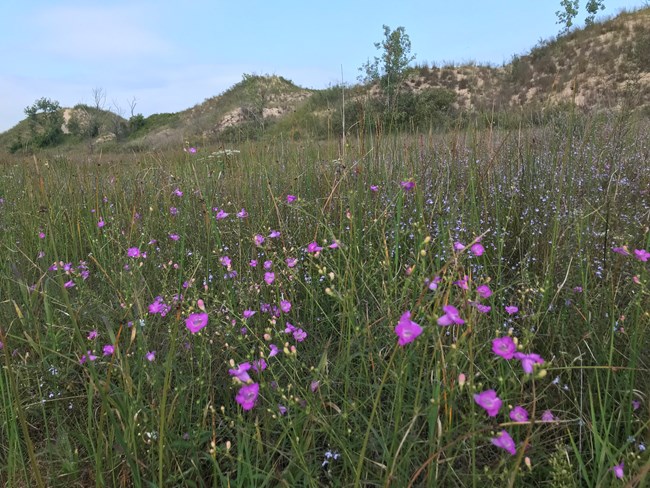Last updated: August 1, 2024
Article
Great Lakes Invasive Plant Management Team Successfully Restores Intradunal Wetland
Thanks to the collaboration between the Great Lakes Invasive Plant Management Team (IPMT) and Indiana Dunes National Park, a globally vulnerable panne ecosystem has been restored after it had previously been overwhelmed by invasive plants.
What is a Panne?
A panne is a type of wetland that occurs between sand dunes, also known as an intradunal wetland. Wetlands are one of the most biodiverse types of ecosystems and provide many ecosystem services including supporting many species of plants and animals, improving water quality, flood control, and erosion control. Pannes are classified as globally vulnerable and contain many endangered and at-risk species. Because of the rarity of the community, pannes are considered a priority natural resource at Indiana Dunes National Park.

NPS Photo
Stacked Odds
Invasive plants had overwhelmed one of the pannes of West Beach, a popular destination at the national park. If left untreated, this site posed a threat to the healthy pannes of Indiana Dunes National Park by serving as a seed source for invasive plants. Some small pockets of native plants remained in the panne and provided hope that the site could be restored if the invasive plants were removed. Restoration of the site began in 2005 with monitoring and inventory done by Indiana Dunes National Park, and in 2009 the national park partnered with the Great Lakes IPMT to control invasive plants. The invasive plant species targeted by the team were common reed (Phragmites australis), hybrid cattails (Typha X glauca), purple loosestrife (Lythrum salicaria), and non-native thistles (Cirsium sp.).
Common reed, which is a grass that stands 1–6 meters (that’s up to 20 ft!), created a dense monoculture that choked out native plants. In addition to their height, this monoculture was created through clonal rhizomes. Rhizomes are a specialized stem that new plants can grow out of. These rhizomes dominate the soil and make nonchemical management nearly impossible within established infestations of common reed. Along with other complications, these factors made the site difficult to navigate, and dead reeds had to be knocked down to facilitate treatment for the next year. Even for the invasive plant control specialists of the Great Lakes IPMT, the reed posed many challenges.
The team also treated hybrid cattail and purple loosestrife. Hybrid cattail is a combination of narrow-leaved cattail (Typha angustifolia) and broad-leaved cattail, (Typha latifolia). Like common reed, hybrid cattails and purple loosestrife spread through rhizomes, creating dense stands that outcompete native vegetation. They also both produce seeds that can last for decades in the soil, creating a seed bank.
When creating the management strategy for the site, biologists considered the characteristics of the invasive species being managed, the presence of remnant native species, and the remoteness of the site. After all factors were reviewed, the control strategy developed by the team was to apply herbicide for multiple consecutive years to remove invasive species and facilitate restoration. The most important action the team took after initial treatment was returning annually to treat the invasive species that grew from the rhizomes and seed bank. Every year, the Great Lakes IPMT returned to the intradunal wetland, enduring the labor of invasive species management through the heat, humidity, and difficult terrain. After nearly 2 decades of consistent, strategic, and uncompromising effort from the Great Lakes IPMT, Indiana Dunes National Park natural resource staff were able to start restoration and revegetation.

Mission Success
After nearly twenty years, the Great Lakes IPMT and Indiana Dunes National Park’s work had paid off. Where once stood a degraded site, now stands a healthy panne. The monoculture of invasive plants is replaced by a variety of native species. Wildflowers bloom where there had been a wall of invasive grass. The site is now a point of pride for both the Great Lakes IPMT and Indiana Dunes National Park.
Indiana Dunes National Park staff continue to monitor the panne annually to ensure the site is maintained and remains an example of a healthy, high-quality, biodiverse, panne ecosystem. Years of consistent effort from the Great Lakes IPMT and Indiana Dunes National Park is commendable, and even more impressive when considering how short a period that is, environmentally speaking. In less than two decades, an ecosystem was restored, and decades of degradation were repaired. Through the partnership of IPMTs and national parks, many restoration projects previously thought not viable can and will become success stories like this one.
Left image
Large patch of Phragmites in a West Beach panne at Indiana Dunes National Park in 2009.
Right image
The same site after restoration in 2022, the Phragmites has been successfully removed and replaced with native species.
